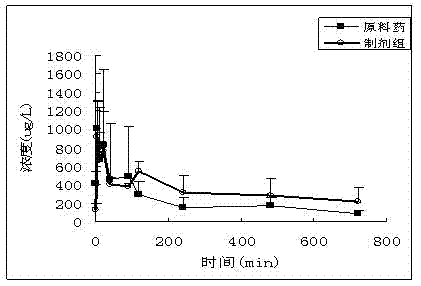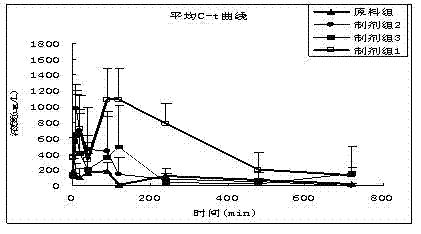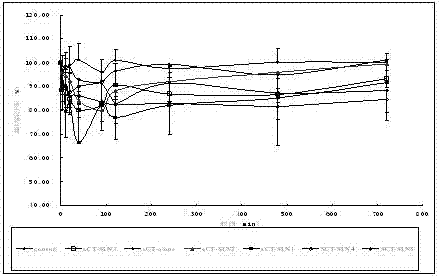Novel solid lipid nanoparticle medicament delivery system for protein-loaded medicaments
A solid lipid nano and solid lipid technology, which is applied in drug delivery, liposome delivery, pharmaceutical formulations, etc., can solve the problems of poor stability of protein drugs, severe preparation process conditions, and low bioavailability, so as to improve biological Utilization, reduction of toxic and side effects, and improvement of therapeutic index
- Summary
- Abstract
- Description
- Claims
- Application Information
AI Technical Summary
Problems solved by technology
Method used
Image
Examples
Embodiment 1
[0072] Example 1 Investigate the impact of biosurfactant concentration on nanoparticle encapsulation efficiency and particle size:
[0073] Investigate the dosage of sodium cholate S Effect of CT-SLNs preparation. Accurately weigh salmon calcitonin ( SCT) 3.75mg was dissolved in 0.5ml of 0.01mol / ml Hcl aqueous solution, after the dissolution was complete, an appropriate amount of sodium cholate was added, vortexed for 30min, and then added to the dissolved 1mg stearic acid, 10mg tripalmitin and 20mg soybean lecithin 1ml of dichloromethane solution. Probe ultrasound 15s, power 40W, the formation of colostrum. Colostrum was added to 4 mL of 0.1% poloxamer 188 solution, and the probe was sonicated for 15 s with a power of 80 W to form a nanoemulsion. Dilute the nanoemulsion with the same concentration of poloxamer 188, and spin evaporate until the dichloromethane is completely evaporated.
[0074] According to the above preparation method, when the dosage of sodium cho...
Embodiment 2
[0075] Example 2 Investigate the type of organic solvent on the size and stability of nanoparticles:
[0076] Examining different organic solvent pairs S CT-SLNs particle size and stability, accurately weighed salmon calcitonin 7.5mg dissolved in 0.5ml 0.01mol / ml HCl aqueous solution, after the dissolution is complete, add an appropriate amount of sodium cholate, and then add dissolved 1mg stearic acid, 20mg of phospholipids in 1ml of organic solvent, the probe ultrasonic 15s, power 40W, to form colostrum. Colostrum was added to 4 mL of 0.1% poloxamer 188 solution, and the probe was sonicated for 15 s with a power of 80 W to form a nanoemulsion. The nanoemulsion was diluted with the same concentration of poloxamer 188 solution, and the SCT-SLNs dispersion was obtained after rotary evaporation until the organic solvent was completely evaporated. 'Medium', 'poor', ' / ' evaluation, wherein 'good' means that after 24 hours of standing, the particle size does not change, and...
Embodiment 3
[0080] Example 3 Investigate the effect of mixing different lipid materials on encapsulation efficiency, particle size and stability:
[0081] Precisely weigh 7.5 mg of salmon calcitonin and dissolve it in 0.5 ml of 0.01 mol / ml HCl aqueous solution. After the dissolution is complete, add 25 mg of sodium cholate, vortex for 30 min, and then add to the solution (according to SLN1, 2, 4 in Table 2). Prescription No. 10 requires adding mixed lipid materials) in 1ml dichloromethane solution of lipid materials in different proportions. Probe ultrasound 15s, power 40W, the formation of colostrum. The colostrum was added to 4mL of 0.1% poloxamer 188 solution, and the probe was ultrasonicated for 15s with a power of 80W to form a nanoemulsion. Dilute the nanoemulsion with the same concentration of poloxamer 188, and spin evaporate until the dichloromethane is completely evaporated. The effects of each formulation on encapsulation efficiency, particle size and stability (stabili...
PUM
 Login to View More
Login to View More Abstract
Description
Claims
Application Information
 Login to View More
Login to View More - R&D
- Intellectual Property
- Life Sciences
- Materials
- Tech Scout
- Unparalleled Data Quality
- Higher Quality Content
- 60% Fewer Hallucinations
Browse by: Latest US Patents, China's latest patents, Technical Efficacy Thesaurus, Application Domain, Technology Topic, Popular Technical Reports.
© 2025 PatSnap. All rights reserved.Legal|Privacy policy|Modern Slavery Act Transparency Statement|Sitemap|About US| Contact US: help@patsnap.com



